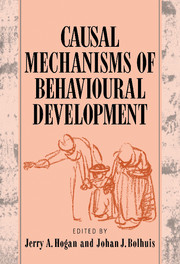Book contents
- Frontmatter
- Contents
- List of contributors
- Foreword: Introducing Jaap Kruijt
- Preface
- Part one Introduction
- Part two Development of perceptual and motor mechanisms
- Part three Development of behaviour systems
- 8 The ontogeny of social displays: interplay between motor development, development of motivational systems and social experience
- 9 Psychobiology of the early mother–young relationship
- 10 Development of behavior systems
- Part four Development of cognition
- Part five Learning and development
- Author index
- Subject index
8 - The ontogeny of social displays: interplay between motor development, development of motivational systems and social experience
Published online by Cambridge University Press: 19 January 2010
- Frontmatter
- Contents
- List of contributors
- Foreword: Introducing Jaap Kruijt
- Preface
- Part one Introduction
- Part two Development of perceptual and motor mechanisms
- Part three Development of behaviour systems
- 8 The ontogeny of social displays: interplay between motor development, development of motivational systems and social experience
- 9 Psychobiology of the early mother–young relationship
- 10 Development of behavior systems
- Part four Development of cognition
- Part five Learning and development
- Author index
- Subject index
Summary
Intraspecific communication is of crucial importance for survival and reproduction in the majority of animal species. Much of this communication takes place by means of ‘displays’, conspicuous, stereotyped and species-specific postures, movements and vocalizations that are specifically adapted to serve as a signal to another member of the species (cf. Tinbergen, 1952). Because of these characteristics, social displays provide interesting material for the study of behavioural development. First, displays are especially suitable for the study of the development of complex stereotyped motor patterns that may be influenced by social experience. Second, the study of display development can provide a better understanding of the ontogeny of social behaviour in general and of the immediate causation of adult social behaviour (Kruijt, 1964). Third, displays are believed to be derived in the course of evolution from intention movements (such as to flee, to attack, to preen) as a result of ritualization and emancipation (Tinbergen, 1952; see below). Because phylogeny is modified ontogeny, changes in ontogeny may reflect changes that have occurred in evolution. Consequently, the study of the ontogeny of displays may also provide insight into the evolution of displays.
Despite these interesting properties of displays, their ontogeny has hardly been analysed quantitatively. A notable exception is the development of bird song. Because of its relation to learning, the discovery of the neural systems involved in song, and the possibility of manipulating feedback by deafening the bird, the study of bird song has become one of the most flourishing fields in ethology.
- Type
- Chapter
- Information
- Causal Mechanisms of Behavioural Development , pp. 183 - 211Publisher: Cambridge University PressPrint publication year: 1994
- 3
- Cited by



